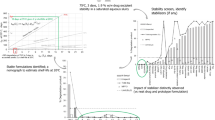Abstract
Purpose
Salts of active pharmaceutical ingredients are often used to enhance solubility, dissolution rate, or take advantage of other improved solid-state properties. The selected form must be maintained during processing and shelf-life to ensure quality. We aimed to develop a model to quantify risk of disproportionation, where the salt dissociates back to the freebase form.
Methods
A mechanistic model based on thermodynamics was built to predict disproportionation. Stress testing of molecules in combination with excipients was used to benchmark model predictions. X-ray powder diffraction and solid-state NMR were used to quantify the formation of freebase experimentally.
Results
13 pharmaceutical compounds were screened in 4 formulations containing different combinations of excipients. The test set spanned molecules which did and did not disproportionate and also formulations which did and did not induce disproportionation. Model predictions were in qualitative agreement with the experimental data, recovering trends of how disproportionation varies with humidity, formulation excipients, base pK a and solubility of the API.
Conclusions
The model can predict the balance between different driving forces for disproportionation with limited experimental data resulting in a tool to aid in early-phase risk assessment and formulation design with respect to disproportionation.








Similar content being viewed by others
References
Serajuddin ATM. Salt formation to improve drug solubility. Adv Drug Del Rev. 2007;59:603–16.
Wermuth CG, Stahl PH editors. Handbook of pharmaceutical salts: properties selection and use. Wiley-VCH; 2002 pp 1–7.
Rohrs BR, Thamann TJ, Gao P, Stelzer DJ, Bergren MS, Chao RS. Tablet dissolution affected by a moisture mediated solid-state interaction between drug and disintegrant. Pharm Res. 1999;16(12):1850–6.
Chen LR, Wesley JA, Bhattachar S, Ruiz B, Bahash K, Babu SR. Dissolution behavior of a poorly water soluble compound in the presence of Tween 80. Pharm Res. 2003;20(5):797–801.
Stephenson GA, Aburub A, Woods TA. Physical Stability of salts of weak bases in the solid-state. J Pharm Sci. 2011;100:1607–17.
Guerrieri P, Taylor LS. Role of salt and excipient properties on disproportionation in the solid-state. Pharm Res. 2009;26:2015–26.
Brittain HG. Strategy for the prediction and selection of drug substance salt forms. Pharm Technol. 2007;31:78–88.
Kramer SF, Flynn GL. Solubility of organic hydrochlorides. J Pharm Sci. 1972;61:1896–904.
Bogardus JB, Blackwood RK. Solubility of doxycycline in aqueous solution. J Pharm Sci. 1979;68:188–94.
Anderson BD, Conradi RA. Predictive relationships in the water solubility of salts of a nonsteroidal anti-inflammatory drug. J Pharm Sci. 1985;74:815–20.
Carstensen JT. Solid state stability. In: Drug stability: principles and practices. 3rd ed. New York: Marcel Dekker; 2000 pp. 166.
Leeson LJ, Mattocks AM. Decomposition of aspirin in the solid-state. J Am Pharm Assoc. 1958;47:329–33.
Carstensen JT, Pothisiri P. Decomposition of para-aminosalicyclic acid in solid-state. J Pharm Sci. 1975;64:37–44.
Hiatt AN, Taylor LS, Mauer LJ. Influence of simultaneous variations in temperature and relative humidity on chemical stability of two vitamin C forms and implications for shelf life models. J Agric Food Chem. 2010;58:3532–40.
Guerrieri P, Jarring K, Taylor LS. Impact of counter ion on the chemical stability of crystalline salts of procaine. J Pharm Sci. 2010;99:3719–30.
Serajuddin ATM, Jarowski CI. Effect of diffusion layer pH and solubility on the dissolution rate of pharmaceutical acids and their sodium salts. Part 2. Salicylic acid, theophylline, and benzoic acid. J Pharm Sci. 1985;74:148–54.
Badawy SIF, Williams RC, Gilbert D. Effect of different acids on solid-state stability of an ester prodrug of an iib/iiia glycoprotein receptor antagonist. Pharm Dev Technol. 1999;4:325–32.
Thakur AB, Morris K, Grosso JA, Himes K, Thottathil JK, Jerzewski RL, et al. Mechanism and kinetics of metal ion-mediated degradation of fosinopril sodium. Pharm Res. 1993;10:800–9.
Serajuddin ATM, Rosoff M. pH-solubility profile of paverine hydrochloride and its relationship to the dissolution rate of sustained-release pellets. J Pharm Sci. 1984;73:1203–8.
Carstensen JT, Rhodes CT. Drug stability: principles and practices. New York: Marcel Dekker; 2000. p. 199.
Pudipeddi M, Zannou EA, Vasanthavada M, Dontabhaktuni A, Royce AE, Joshi YM, et al. Measurement of Surface pH of pharmaceutical Solids: a critical evaluation of indicator dye-sorption method and its comparison with slurry pH method. J Pharm Sci. 2008;97:1831–42.
Govindarajam R, Zinchuk A, Hancock B, Shalaev E, Suryanarayanan R. Ionization states in the microenvironment of solid dosage forms: effect of formulation variables and processing. Pharm Res. 2006;23(10):2454–68.
Qiu Y, Chen Y, Liu L, Zhang G. Developing solid oral dosage forms: pharmaceutical theory and practice. p130.
Li Y, Sanzgiri YD, Chen Y. A study on moisture isotherms of formulations: the use of polynomial equations to predict the moisture isotherms of tablet products AAPS Pharm Sci Tech; 2003 4(4) Article 59.
Brown ME, Glass BD. Pharmaceutical applications of the Prout-Tompkins rate equation. Int J Pharm. 1999;190:129–37.
Zannou EA, Ji Q, Joshi YM, Serajuddin ATM. Stabilization of the maleate salt of a basic drug by adjustment of microenvironmental pH in solid dosage form. Int J Pharm. 2007;337:210–8.
Acknowledgments and Disclosures
Tim Woods, Adam McFarland, John Rose, Susan Reutzel-Edens, Bob Behme, and Ron Iacocca are thanked for many fruitful discussions.
Author information
Authors and Affiliations
Corresponding author
Electronic supplementary material
Below is the link to the electronic supplementary material.
ESM 1
(DOCX 192 kb)
Rights and permissions
About this article
Cite this article
Merritt, J.M., Viswanath, S.K. & Stephenson, G.A. Implementing Quality by Design in Pharmaceutical Salt Selection: A Modeling Approach to Understanding Disproportionation. Pharm Res 30, 203–217 (2013). https://doi.org/10.1007/s11095-012-0863-9
Received:
Accepted:
Published:
Issue Date:
DOI: https://doi.org/10.1007/s11095-012-0863-9




